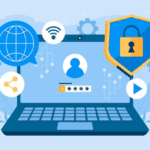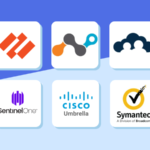Table Of Content
The Definitive Data Loss Prevention (DLP) Guide for Infosec Users
- May 18, 2024
Summary: Data is the lifeblood of modern businesses- but what happens when it leaks, gets stolen, or falls into the wrong hands? Data Loss Prevention (DLP) is the cybersecurity shield that stops sensitive information from falling into the wrong hands.
Data is the lifeblood of modern businesses- but what happens when it leaks, gets stolen, or falls into the wrong hands? Data Loss Prevention (DLP) is the cybersecurity shield that stops sensitive information from falling into the wrong hands.
In this guide, we’ll break down:
- What DLP means in security and why it’s critical
- How DLP works to classify, monitor, and block data threats
- Key DLP controls for compliance and risk reduction
- Real-world DLP examples and use cases
Let’s dive right in.
What is Data Loss Prevention and What Does It Stand for in Security?
Data Loss Prevention (DLP) is a security solution that helps businesses detect, monitor, and prevent unauthorized access or leakage of sensitive data. DLP tools are used by organizations of all sizes to achieve three key goals: protect data, comply with regulations, and reduce security risks.
The primary function of DLP is to identify and classify sensitive data, such as customer records, financial details, and intellectual property, across emails, cloud storage, and endpoints. From accidental leaks to malicious breaches, DLP ensures your critical information stays secure.
Many DLP systems also provide real-time monitoring, encryption, and policy enforcement to prevent data exposure. These tools help security teams detect threats before they escalate.
According to Gartner’s 2023 Market Guide, businesses using DLP reduce data breach risks by over 60%. If you want to safeguard your data while maintaining compliance, DLP is essential.
100s of customers worldwide trust Kitecyber’s DLP for uncompromising data security—are you ready to join them?
Start your free trial today and experience:
- Effortless Compliance: 80+ pre-defined templates for rapid setup
- Cross-Platform Protection: Track data lineage on Windows, Linux, and MacOS
- Insightful Analytics: Monitor copy-paste, uploads, Airdrop transfers, and more
- Proven Success: Trusted by clients across industries in the US and India
- Always-On Support: 24x7 dedicated assistance for complete peace of mind
Types of Data Loss for Organizations
Understanding the different types of data loss helps organizations implement appropriate protection measures:
Accidental Data Loss
- Employee mistakes (deleting files, sending to wrong recipients)
- System or application errors
- Hardware failures or corruption
- Natural disasters affecting physical infrastructure
Malicious Data Loss
- External attacks (hacking, malware, ransomware)
- Insider threats (disgruntled employees, corporate espionage)
- Social engineering attacks
- Theft of physical devices
Data Leakage Channels
- Email and messaging platforms
- Cloud storage and file sharing services
- Removable media (USB drives, external hard drives)
- Mobile devices and applications
- Printing and physical document removal
- Screen captures and photography
- Unsecured network connections
What is Data Loss Prevention (DLP) Used For?
A strong DLP solution provides visibility and control over sensitive data. It also enforces security policies to prevent leaks. The best DLP tools help businesses:
1. Prevent Data Leaks
DLP scans and classifies sensitive data across emails, cloud apps, and endpoints. If an employee tries to send confidential files outside the company, DLP blocks the action and alerts IT.
For example, a healthcare provider can use DLP to stop unauthorized sharing of patient records. A financial firm can prevent credit card details from being emailed to personal accounts.
2. Ensure Compliance
Industries like finance, healthcare, and government must follow strict data protection laws (GDPR, HIPAA, PCI-DSS). DLP helps enforce these rules by:
- Automatically redacting sensitive data in emails and documents
- Logging access attempts for audits
- Blocking non-compliant transfers
Without DLP, businesses risk heavy fines and reputational damage.
3. Secure Cloud & Remote Work
With employees accessing data from multiple locations, DLP extends protection to:
- Cloud storage (Google Drive, OneDrive, Dropbox)
- Collaboration tools (Slack, Microsoft Teams)
- Personal devices (BYOD policies)
DLP ensures sensitive files can’t be downloaded, shared, or uploaded without approval.
4. Stop Insider Threats
Not all data breaches come from hackers. Employees or illegitimate insiders can accidentally (or intentionally) leak data. DLP detects risky behavior like:
- Mass downloads of confidential files
- Unauthorized USB transfers
- Screenshots of restricted documents
With some DLP solutions, Security teams receive real-time alerts to investigate and respond.
5. Protect Intellectual Property
DLP helps businesses safeguard trade secrets, patents, and proprietary data. By monitoring file movements, companies can prevent corporate espionage or competitive leaks.
Why DLP Matters in 2025
How Data Loss Prevention Works
- 83% of organizations suffer data breaches from insider threats.
- GDPR fines can hit €20M or 4% of global revenue for leaks.
- Cloud adoption (Slack, Teams, ChatGPT) expands attack surfaces.
Data Loss Prevention (DLP) software protects sensitive data by identifying and controlling its use. A DLP software works by monitoring, detecting, and preventing unauthorized data sharing. DLP applies policies to secure data at rest, in use, and in motion.
Identifying Sensitive Data
DLP uses these methods to detect sensitive information:
- Regular Expression Matching: Spots patterns like Social Security numbers.
- Exact Data Matching: Matches specific values, like customer records.
- Exact File Matching: Uses hash codes to protect specific files.
- Partial Document Matching: Detects excerpts from sensitive documents.
- Machine Learning: Flags content similar to sensitive data.
Securing Email Communication
When an email is sent externally, the email gateway:
- Scans content, headers, and attachments for sensitive data.
- Evaluates context to avoid false positives (e.g., credit card numbers with expiration dates).
- Applies the first matching DLP policy in the defined order.
- Assigns a risk score (0–100) and severity level.
- Takes action like blocking or quarantining based on the policy.
Protecting Data in Different States
DLP secures data in three states:
- Storage DLP: Protects data on servers or databases with policies like encryption.
- Network DLP: Monitors network traffic to prevent data leaks. Integrates with email MTAs for outgoing messages.
- Endpoint DLP: Restricts actions on user devices, like copying or sharing data.
Handling Violations
Upon detecting sensitive data, DLP can:
- Alert management or compliance teams.
- Warn users via email.
- Quarantine files by moving or encrypting them.
- Delete violating files.
- Block uploads or external emails.
Key Components of DLP Solutions
Best Data Loss Prevention Solutions have following key components:
Data Discovery
Tools that scan networks, endpoints, and storage repositories to locate sensitive information that requires protection. This provides visibility into where valuable data resides.
Content Inspection
Technologies that examine the content of files, emails, and web communications to identify sensitive information based on predefined patterns, keywords, or file types.
Policy Management
Centralized controls for creating, managing, and enforcing data protection policies across the organization. Policies define what constitutes protected data and what actions are permitted.
Monitoring and Analytics
Continuous observation of data movement combined with analytical capabilities to detect patterns, anomalies, and potential threats.
Incident Management
Systems for documenting, investigating, and responding to potential data loss events, including workflow features for escalation and resolution.
Reporting and Compliance
Tools for generating documentation needed to demonstrate regulatory compliance and measure program effectiveness.
Data Loss Prevention Implementation Strategies
1. Planning Your DLP Initiative
- Data Assessment: Identify sensitive data types (e.g., PII, financial records) and map their storage locations (on-premises, cloud, endpoints).
- Risk Assessment: Prioritize data assets based on threat exposure, regulatory requirements, and business impact.
- Policy Development: Design clear, actionable policies aligned with compliance standards (GDPR, HIPAA) and operational goals.
- Solution Selection: Choose tools tailored to your environment (cloud, hybrid) and specific risks (insider threats, external breaches).
- Phased Rollout: Begin with critical data/assets, then expand coverage iteratively to minimize disruption.
2. Deployment Approaches
- Monitoring Mode: Start with observation-only deployment to baseline data flows and user behavior.
- Targeted Protection: Focus initial enforcement on high-risk data (e.g., intellectual property, customer data).
- Education-First: Train employees on data handling before enabling automated blocking.
- Full Enforcement: Gradually shift to strict policy execution with automated alerts and remediation.
3. Integration Requirements
Effective DLP requires seamless integration with:
- Identity and access management (IAM) systems
- SIEM solutions for centralized threat detection
- Cloud access security brokers (CASBs)
- Email security gateways
- Endpoint protection platforms
- Data classification tools
Your Data Deserves Better Protection—Choose Kitecyber’s DLP!
- Instant Compliance: 80+ ready-to-use templates for rapid deployment.
- Multi-Platform Protection: Secure data across Windows, Linux, and macOS.
- Smart Monitoring: Detect risky actions—copy, upload, AirDrop, and beyond.
- Trusted by Top Brands: Safeguarding businesses across the US and India.
- Always-On Support: 24/7 dedicated assistance, whenever you need it.
Common Data Loss Prevention Challenges and Solutions
Organizations have long relied on legacy data protection tools to secure their corporate data. But these deployments are rife with challenges. When we talk to organizations struggling with these traditional data protection tools, there are some important challenges along with their solutions:
1. Challenge: High False Positive Rates
Solution: Fine-tune detection rules, implement machine learning-based detection, and continuously refine policies based on feedback.
2. Challenge: User Resistance
Solution: Involve users in policy development, provide clear explanations, implement gradually, and focus on education.
3. Challenge: Encryption Blind Spots
Solution:Implement endpoint controls that can inspect content before encryption and deploy solutions that maintain visibility into encrypted traffic.
4. Challenge: Cloud Environment Protection
Solution: Use Cloud Access Security Brokers (CASBs) and cloud-native DLP tools designed specifically for cloud platforms.
5. Challenge: Managing Exceptions
Solution: Create a formal exception management process with appropriate approvals and time limits.
6. Challenge: Mobile Device Coverage
Solution: Implement Mobile Device Management (MDM) with integrated DLP capabilities.
Examples of Data Loss Prevention Systems in Different Environments
Data Loss Prevention (DLP) systems come in various forms, tailored to different environments and security needs. Here’s a breakdown of common DLP software examples along with their applications:
Endpoint DLP
Protection Focus: Endpoint DLP software secures data on user devices (laptops, mobile phones, etc.). An endpoint DLP solution works across different types of devices and operating systems. Examples include Mac DLP, Linux DLP
Key Features :
Key Features :
- Application/Device Control: Block unauthorized apps or USB devices.
- Content Monitoring: Track sensitive data transfers.
- Screenshot/Clipboard Control: Prevent data leakage via screenshots or copy-paste.
Network DLP
Protection Focus: Monitors data in motion across networks.
Key Features :
- Deep Packet Inspection: Analyze traffic for sensitive data.
- Web/Email Scanning: Block unauthorized data transfers via web or email.
- Protocol Analysis: Detects anomalies in data transmission protocols.
Cloud DLP
Protection Focus: Safeguards data in SaaS apps (e.g., Slack, Google Drive) and cloud storage.
Key Features :
- API-Based Scanning: Monitor cloud data via native integrations.
- Shadow IT Discovery: Identify unsanctioned cloud apps.
- Third-Party Governance: Control data shared with external vendors.
Database DLP
Protection Focus: Protects structured data in databases (e.g., SQL, NoSQL).
Key Features:
- Access Control: Restrict unauthorized queries or exports.
- Masking/Tokenization: Hide sensitive data in non-production environments.
- Activity Monitoring: Alert on suspicious database queries.
Compliance Requirements & DLP: Ensuring Regulatory Adherence
1. Compliance Requirements Overview
Regulatory frameworks like HIPAA, GDPR, ITAR, PCI-DSS and CCPA mandate strict controls over sensitive data. Organizations must:
- Identify and classify data: Pinpoint PII, PHI, financial records, or intellectual property.
- Monitor data flows: Track how data is accessed, shared, or transferred.
- Report incidents: Notify authorities and affected parties of breaches within stipulated timelines.
- Maintain audit trails: Provide logs for regulatory audits to prove compliance.
DLP’s Role:
- Data Discovery & Classification:Automatically scan and tag sensitive data across endpoints, networks, and cloud systems.
- Activity Monitoring: Detects unauthorized access, transfers, or modifications.
- Incident Response: Generate real-time alerts and enforce policies (e.g., blocking unauthorized exports).
- Audit Readiness: Centralize logs and reports for compliance demonstrations.
2. Examples of DLP in Compliance
HIPAA (Health Insurance Portability and Accountability Act)
Focus: Protecting electronic Protected Health Information (ePHI).
DLP Solutions :
- Data Classification : Identify ePHI in medical records, insurance claims, or emails.
- Network Monitoring : Block unauthorized transfers of patient data to external networks or personal devices.
- Endpoint Controls : Prevent copying ePHI to USB drives or cloud storage without encryption.
- Audit Trails : Maintain logs of ePHI access for HIPAA audits.
GDPR (General Data Protection Regulation)
Focus : Securing EU residents’ personal data (name, email, biometrics).
DLP Solutions :
- Data Mapping : Discover and classify PII across on-premises and cloud systems.
- Cross-Border Transfer Controls : Block unauthorized data exports outside the EU.
- Breach Notification : Automatically flag and report breaches within 72 hours (as required).
- Right to Erasure : Locate and delete user data upon request via DLP-driven workflows.
ITAR (International Traffic in Arms Regulations)
Focus : Restricting access to defense-related data (e.g., technical specs, military tech).
DLP Solutions :
- Export Controls : Monitor and block unauthorized sharing of ITAR-controlled data with foreign entities.
- User Activity Monitoring : Detects insider threats, such as unusual downloads or external collaborations.
- Encryption Enforcement : Ensure ITAR data is encrypted at rest and in transit.
PCI DSS (Payment Card Industry Data Security Standard)
Focus : Securing cardholder data (e.g., credit card numbers).
DLP Solutions :
- Masking Sensitive Data : Hide PANs (Primary Account Numbers) in logs and reports.
- Transaction Monitoring : Detects and blocks suspicious card data transfers.
- Access Controls : Restrict cardholder data access to authorized personnel only.
Conclusion
Data Loss Prevention is not merely a technology implementation but a comprehensive program that encompasses people, processes, and technology. Successful DLP requires a strategic approach that balances security requirements with business needs and user experience.
As organizations continue to collect and process more data, and as regulatory requirements become more stringent, DLP will remain a critical component of information security strategies. By following the best practices outlined in this guide and adapting them to your specific organizational context, you can significantly reduce the risk of data loss and its potentially devastating consequences.
While looking for DLP solutions, we believe that one needs to find a solution which covers both data at rest and in transit. Also, look for a trade-off between how intrusive the solution is vs the protection it provides. In many cases, the adoption is limited because users are not comfortable with the privacy loss in many of the solutions. We believe that endpoint based solutions that can monitor data at the endpoint and also monitor traffic leaving the endpoint can provide a good sweet spot to balance these concerns. And no data is ever decrypted outside the endpoint itself.
As organizations continue to collect and process more data, and as regulatory requirements become more stringent, DLP will remain a critical component of information security strategies. By following the best practices outlined in this guide and adapting them to your specific organizational context, you can significantly reduce the risk of data loss and its potentially devastating consequences.
While looking for DLP solutions, we believe that one needs to find a solution which covers both data at rest and in transit. Also, look for a trade-off between how intrusive the solution is vs the protection it provides. In many cases, the adoption is limited because users are not comfortable with the privacy loss in many of the solutions. We believe that endpoint based solutions that can monitor data at the endpoint and also monitor traffic leaving the endpoint can provide a good sweet spot to balance these concerns. And no data is ever decrypted outside the endpoint itself.
With over a decade of experience steering cybersecurity initiatives, my core competencies lie in network architecture and security, essential in today's digital landscape. At Kitecyber, our mission resonates with my quest to tackle first-order cybersecurity challenges. My commitment to innovation and excellence, coupled with a strategic mindset, empowers our team to safeguard our industry's future against emerging threats.Since co-founding Kitecyber, my focus has been on assembling a team of adept security researchers to address critical vulnerabilities and enhance our network and user security measures. Utilizing my expertise in the Internet Protocol Suite (TCP/IP) and Cybersecurity, we've championed the development of robust solutions to strengthen cyber defenses and operations.
Posts: 35





